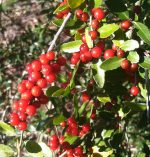 This thicket-forming evergreen shrub or small tree is native to sandy woods, dunes, open fields, forest edges, and wet swamps especially in the coastal plain and maritime forests from Virginia to Florida, Arkansas, and Texas. It is a member of the holly family, Aquifoliaceae, that consists of one genus, Ilex, with 480 species. Plants grow 10-20′ tall and have glossy, dark green, elliptical to oblong leaves up to 1.5″ long and with wavy toothed margins. In spring, fragrant, inconspicuous greenish-white male and female flowers appear on different plants and are attractive to butterflies. The female flowers give way to red berry-like fruits about 1/4″ across that persist into winter and are attractive to birds. Plants can take hard pruning so are good subjects for topiary and edging of parterres. They form good hedges, screens and windbreaks and can be used in wildlife, butterfly, and native plant gardens. Many cultivars are available that vary most significantly in size. The genus name, Ilex, is the Latin name for holm-oak and refers to the similarity of the leaves of holm-oak and yaupon holly. The specific epithet, vomitoria, is the Latin word for causing vomiting and refers to the use of the plant by native American as an emetic.
This thicket-forming evergreen shrub or small tree is native to sandy woods, dunes, open fields, forest edges, and wet swamps especially in the coastal plain and maritime forests from Virginia to Florida, Arkansas, and Texas. It is a member of the holly family, Aquifoliaceae, that consists of one genus, Ilex, with 480 species. Plants grow 10-20′ tall and have glossy, dark green, elliptical to oblong leaves up to 1.5″ long and with wavy toothed margins. In spring, fragrant, inconspicuous greenish-white male and female flowers appear on different plants and are attractive to butterflies. The female flowers give way to red berry-like fruits about 1/4″ across that persist into winter and are attractive to birds. Plants can take hard pruning so are good subjects for topiary and edging of parterres. They form good hedges, screens and windbreaks and can be used in wildlife, butterfly, and native plant gardens. Many cultivars are available that vary most significantly in size. The genus name, Ilex, is the Latin name for holm-oak and refers to the similarity of the leaves of holm-oak and yaupon holly. The specific epithet, vomitoria, is the Latin word for causing vomiting and refers to the use of the plant by native American as an emetic.
Type: Evergreen shrub
Outstanding Feature: Berries, foliage
Form: Rounded
Growth Rate: Slow
Bloom: Inconspicuous greenish white flowers in spring
Size: 10-20′ H x 8-12′ W
Light: Full sun to shade
Soil: Average, medium moist to wet, well-drained
Hardiness: Zones 7-9
Care: Remove suckers to control size and spread; can prune hard.
Pests and Diseases: Susceptible to holly leaf miner, spider mites, whitefly, sacale, laef spot, leaf rot, tar spot, and powdery mildew.
Propagation: Seed, cuttings
Outstanding Selections:
‘Bordeaux’
‘Nana’ (dwarf)
‘Pendula’ (weeping)
‘Stokes Dward’
‘Taylor’s Rudolph’ (dwarf)
‘Virginia Dare’
‘Will Fleming’
Photo Credit: Wikimedia